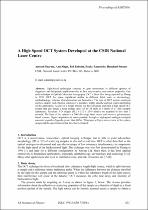JavaScript is disabled for your browser. Some features of this site may not work without it.
- ResearchSpace
- →
- Research Publications/Outputs
- →
- Conference Publications
- →
- View Item
| dc.contributor.author |
Sharma, Ameeth

|
|
| dc.contributor.author |
Singh, Ann

|
|
| dc.contributor.author |
Roberts, Ted

|
|
| dc.contributor.author |
Ramokolo, Lesiba R

|
|
| dc.contributor.author |
Strauss, Hencharl J

|
|
| dc.date.accessioned | 2018-05-28T07:33:18Z | |
| dc.date.available | 2018-05-28T07:33:18Z | |
| dc.date.issued | 2016-07 | |
| dc.identifier.citation | Sharma, A., Singh, A., Roberts, T., Ramokolo, L.R. and Strauss, H.J. 2016. A high speed OCT system developed at the CSIR National Laser Centre (paper). In: The 61st Annual Conference of the South African Institute of Physics (SAIP 2016), 4-8 July 2016, Cape Town, South Africa | en_US |
| dc.identifier.isbn | 978-0-620-77094-1 | |
| dc.identifier.uri | http://events.saip.org.za/getFile.py/access?resId=1&materialId=9&confId=86 | |
| dc.identifier.uri | http://hdl.handle.net/10204/10241 | |
| dc.description | Presented at: The 61st Annual Conference of the South African Institute of Physics (SAIP 2016), 4-8 July 2016, Cape Town, South Africa. | en_US |
| dc.description.abstract | Light-based techniques continue to gain momentum in different spheres of diagnostic and therapeutic applications due to their non-invasive, non-contact properties. One such technique is Optical Coherence tomography (OCT). Since first being reported by Huang in 1991, OCT has made significant strides in different fields such as dermatology, ophthalmology, polymer characterisation and biometrics. The type of OCT system employed can be a simple, cost effective solution or a complex, highly specific and fast system depending on the application. As part of a larger project, we have designed and built a high speed OCT system that can image a large surface area (25 by 25 mm) to a depth of 11 mm (sample dependant). Resultant 3-D images (512 x 512 x 2048 pixels) are acquired in less than 3 seconds. The heart of the system is a 200 kHz swept laser source and two-axis galvanometer based scanner. Signal acquisition is made possible through a high-speed analogue-to-digital converter capable of speeds greater than 1GS/s. This paper will give an overview of the system design and the specifications that have been obtained. | en_US |
| dc.language.iso | en | en_US |
| dc.publisher | The South African Institute of Physics | en_US |
| dc.relation.ispartofseries | Workflow;20222 | |
| dc.subject | High speed | en_US |
| dc.subject | 3D | en_US |
| dc.subject | Optical coherence tomography | en_US |
| dc.subject | Security | en_US |
| dc.title | A high speed OCT system developed at the CSIR National Laser Centre (paper) | en_US |
| dc.type | Conference Presentation | en_US |
| dc.identifier.apacitation | Sharma, A., Singh, A., Roberts, T., Ramokolo, L. R., & Strauss, H. J. (2016). A high speed OCT system developed at the CSIR National Laser Centre (paper). The South African Institute of Physics. http://hdl.handle.net/10204/10241 | en_ZA |
| dc.identifier.chicagocitation | Sharma, Ameeth, Ann Singh, Ted Roberts, Lesiba R Ramokolo, and Hencharl J Strauss. "A high speed OCT system developed at the CSIR National Laser Centre (paper)." (2016): http://hdl.handle.net/10204/10241 | en_ZA |
| dc.identifier.vancouvercitation | Sharma A, Singh A, Roberts T, Ramokolo LR, Strauss HJ, A high speed OCT system developed at the CSIR National Laser Centre (paper); The South African Institute of Physics; 2016. http://hdl.handle.net/10204/10241 . | en_ZA |
| dc.identifier.ris | TY - Conference Presentation AU - Sharma, Ameeth AU - Singh, Ann AU - Roberts, Ted AU - Ramokolo, Lesiba R AU - Strauss, Hencharl J AB - Light-based techniques continue to gain momentum in different spheres of diagnostic and therapeutic applications due to their non-invasive, non-contact properties. One such technique is Optical Coherence tomography (OCT). Since first being reported by Huang in 1991, OCT has made significant strides in different fields such as dermatology, ophthalmology, polymer characterisation and biometrics. The type of OCT system employed can be a simple, cost effective solution or a complex, highly specific and fast system depending on the application. As part of a larger project, we have designed and built a high speed OCT system that can image a large surface area (25 by 25 mm) to a depth of 11 mm (sample dependant). Resultant 3-D images (512 x 512 x 2048 pixels) are acquired in less than 3 seconds. The heart of the system is a 200 kHz swept laser source and two-axis galvanometer based scanner. Signal acquisition is made possible through a high-speed analogue-to-digital converter capable of speeds greater than 1GS/s. This paper will give an overview of the system design and the specifications that have been obtained. DA - 2016-07 DB - ResearchSpace DP - CSIR KW - High speed KW - 3D KW - Optical coherence tomography KW - Security LK - https://researchspace.csir.co.za PY - 2016 SM - 978-0-620-77094-1 T1 - A high speed OCT system developed at the CSIR National Laser Centre (paper) TI - A high speed OCT system developed at the CSIR National Laser Centre (paper) UR - http://hdl.handle.net/10204/10241 ER - | en_ZA |






